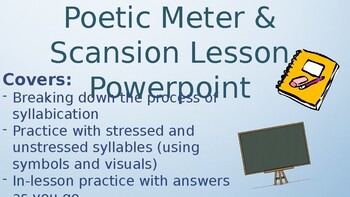

So, for example, if we were going to scan the first line of Twelfth Night, it might look a little something like this:

Here at Shmoop, we scan poems all the time, and we mark our stresses with both bold and italic font. When you practice scansion-when you scan-you read a line of poetry, counting its feet, finding the stresses, all in the name of sussing out which meter it follows (if any). So iambic pentameter describes poetry written in a ten-line, alternating stress structure.This fancy term simply refers to the process of analyzing a poem's meter. Pentameter indicates there are ten syllables in the line. Iambic means to have two syllables, one stressed and one unstressed. Meter defines the number of feet in a single line of poetry. dispondee ( ʹ ʹ ʹ ʹ ) - A four-syllable foot where all four syllables are stressed.fourth epitrite ( ʹ ʹ ʹ ˘ ) - A four-syllable foot where only the fourth syllable is unstressed.third epitrite ( ʹ ʹ ˘ ʹ ) - A four-syllable foot where only the third syllable is unstressed.second epitrite ( ʹ ˘ ʹ ʹ ) - A four-syllable foot where only the second syllable is unstressed.first epitrite ( ˘ ʹ ʹ ʹ ) - A four-syllable foot where only the first syllable is unstressed.antispast ( ˘ ʹ ʹ ˘ ) - A four-syllable foot where the second and third syllables are stressed.choriamb ( ʹ ˘ ˘ ʹ ) - A four-syllable foot where the second and third syllables are unstressed.diiamb ( ˘ ʹ ˘ ʹ ) - A four-syllable foot where the first and third syllables are unstressed.ditrochee ( ˘ ʹ ˘ ʹ ) - A four-syllable foot where the first and third syllables are stressed.minor ionic or double iamb ( ˘ ˘ ʹ ʹ ) - A four-syllable foot where the first and second syllables are unstressed.


iamb ( ˘ ʹ ) - A two-syllable foot where an unstressed syllable is followed by a stressed syllable.There are three common types of feet- disyllable feet, trisyllable feet, and tetrasyllable (ionic) feet: Disyllable Feet: What are feet?Ī foot is a group of two or three syllables. Now the macron is commonly replaced with an ictus ( ʹ ) above a long syllable. Classical notation uses a macron ( - ) for long syllables and a breve ( ˘ ) for short syllables. Over the years, many different systems have been established to mark the scansion of a poem. In both cases, the meter often has a regular foot. In classical poetry, these patterns are based on the different lengths of each vowel sound, and in English poetry, they are based on the different stresses placed on each syllable. What is scansion?Ī system of scansion is a way to mark the metrical patterns of a line of poetry. There can be multiple ways to scan a line of verse to find the natural pulse. Scansion is very helpful in determining the natural rhythm of speaking blank verse.


 0 kommentar(er)
0 kommentar(er)
